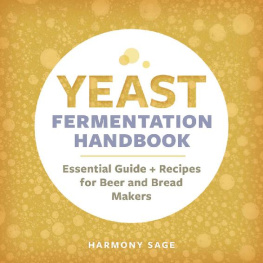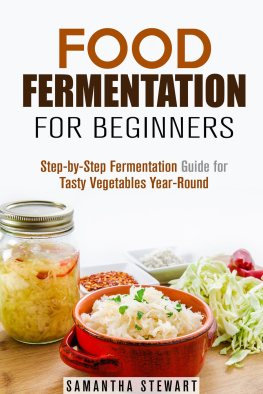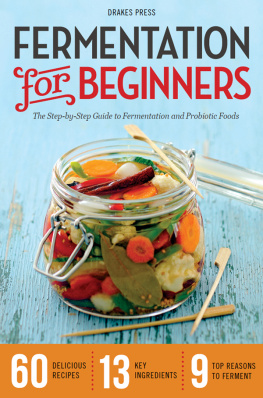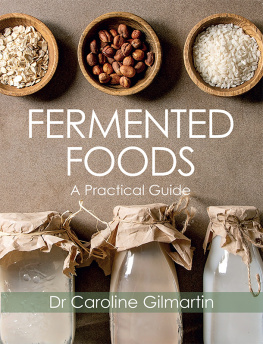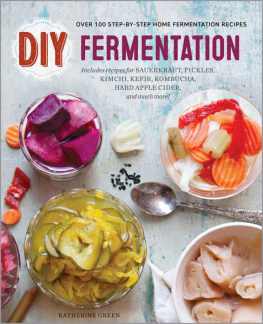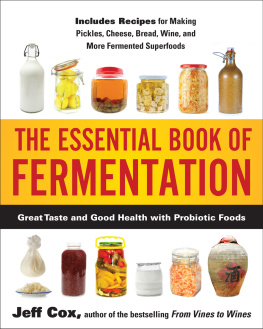From the creator of FermUp.com
THE EVERYDAY
FERMENTATION
HANDBOOK
A Real-Life Guide to Fermenting Food Without Losing Your Mind or Your Microbes
BRANDEN BYERS

Avon, Massachusetts
PRAISE FOR THE EVERYDAY FERMENTATION HANDBOOK
The Everyday Fermentation Handbook is a refreshingly clear guide to the sometimes elusive world of fermentation. From simply elegant (leek rings) to brilliantly bizarre (peanut butter and sauerkraut cream cookies), Branden Byers gives us an honest and creative take on making and using fermented foods at home.
Benjamin Wolfe, microbiologist at Harvard University and regular contributor to Lucky Peach
With this book, Branden Byers has offered a gateway into the world of fermentation that will calm the fears of new fermenters and help more experienced bacteria-lovers perfect their game. Very specific instructions, lovely photos, and a fascinating breadth of coverage on ferments of all kinds make The Everyday Fermentation Handbook a book you can actually use every day. Branden dives in to bubbly vats of well-loved and lesser-known ferments, embodying the spirit of fermentation and experimentation with inventive recipes and a lively exploration of the science behind these exciting foods.
Amanda Feifer, founder of Phickle.com
I really enjoy The Everyday Fermentation Handbook from fermentation raconteur/podcaster Branden Byers. This is a great book for anyone who appreciates this eons-old tradition of food preservation, which has been briefly interrupted by the postwar allure of faster-better-cheaper industrial food production and modern conveniences. It provides the reader with the confidence needed to resurrect and make practical (and delicious!) use of these precious cultural traditions.
Austin Durant, founder of Fermenters Club
Fermentation is a wonderful and transformative process of food that is easy to embrace for its health-giving properties and exotic taste, but often it can be hard to change our habits to incorporate these in our everyday diet. This is a practical book that gives you inspiration and confidence to do so. It is easy to use for the beginner as well as the more experienced fermenter with good and easy-to-follow recipes.
Eva Bakkeslett, artist, cultivator, and fermenter
Brandens knowledge and excitement about the science and flavors of fermented foods is considerable. Ive been lucky to witness this enthusiasm spread to others with his teachings of both beginner and advanced-level fermentation topics.
Philip Crawford, board member of Slow Food Madison and founder of Madison Food Camp
Brandens new book gives beginners an engaging look at the world of fermented foods, guiding us through simple processes that are easily incorporated into our everyday routines. Step by step, the book inspires us with the confidence to experiment and explore new flavors, textures, and foods we may not be familiar with. Before you know it, your larder will be filled with delicious, healthy kimchi, heirloom yogurts, sourdough breads, and fermented drinks! With more than thirty inventive recipes that make the most of the bright, tart, spicy flavors found in fermented foods, snacks and mealtimes become a whole new adventure. Kimchi Pizza, anyone?
Kim Bartko, program director of Good Food Festival
Byers demystifies the dark art of fermentation, outlining techniques and processes using plain English in an affable, approachable voice. Newcomers to the world of controlled rot will be inspired into action starting with simple and accessible projects like sauerkraut and yogurt, but by casting a global net, Byers offers up a world of inspiration for even experienced fermenters.
Sean Timberlake, founder of Punk Domestics
CONTENTS
INTRODUCTION
Fermentation is everywhere. Its a natural process, and humans, over the ages, have managed to control enough of the process in order to make a few delicious and healthy foods.
Its a great way to get healthy foods into your diet. Of course, you can buy some fermented foods in the store, and probably do; your shopping list undoubtedly includes things like pickles and possibly sauerkraut. However, in this book youll find recipes free of preservatives and artificial ingredients for these delicious treatsmuch healthier than anything you can buy in a store. There are other health benefits: For example, as youll see later, fermentation breaks down lactose in dairy products.
Fermenting can preserve foods. Not surprisingly, many of the recipes for fermenting were first developed at a time when most humans didnt have access to refrigeration. Fermentation was a way around this problem. Today, it can make storing foods much simpler.
Finally, of course, fermented foods are delicious and fun. We live in an age of refrigeration and highly processed foods. Most people are no longer required to preserve food in times of abundance in order to be able to survive extended periods of scarcity such as long winters. Now most humans can ferment food as a luxury.
I love fermented foods because I get to play amateur scientist in my kitchen. Learning about new ferments from around the world is an opportunity for me to explore where these foods originated and the necessity or desires that once shaped the fermentation process. And of course there are the flavors; although a picky eater as a child, I now crave the complex, intense, and sometimes funky flavors of fermented foods.
With all of this comes the opportunity to share knowledge with others. What were once commonplace traditions, passed down from one generation to the next, have in many cases been lost. The invention of alternatives and conveniences over the past couple hundred years has meant too few parents and grandparents handing down the skills of fermentation to the next generation.
While fermented foods can be purchased from commercial producers, its possible to make a lot more than what can be found in the grocery store. Some fermented foods are too strange for mass appeal and so are relegated to limited regions or not produced commercially at all.
Fermented foods dont require specialized equipment, they offer endless possibilities, and often theyre less expensive to make than buy.
For most people, the hardest part is figuring out where to store ferments in progress and how to plan ahead so that fermented foods are ready to eat when desired. Its disappointing to crave sauerkraut or kimchi and then realize that either the next batch still has two weeks to finish or that you never started it in the first place. Even worse is to lose a starter culture of sourdough or heirloom yogurt that cant be easily replaced. Throughout this book you will find tips and suggestions to ensure you have fermented food ready to serve whenever you so desire.
Whether you are looking for ways to incorporate one or one hundred different homemade fermented foods into your life, the recipes in this book will help you get started. Fermentation does take time and patience but the learning curve is gradual. Start simple with something that sounds appetizing and the next thing you know, you may have a zoo of microbial diversity fermenting in your home, too. Enter the world of fermentation and you will never feel alone in the kitchen again.
PART 1
THE BASICS
These first chapters will give you a basic understanding of fermentation and an overview of the general techniques used throughout this book. If you decide to jump directly to the recipes, then refer to this section if specific directions confuse you.


